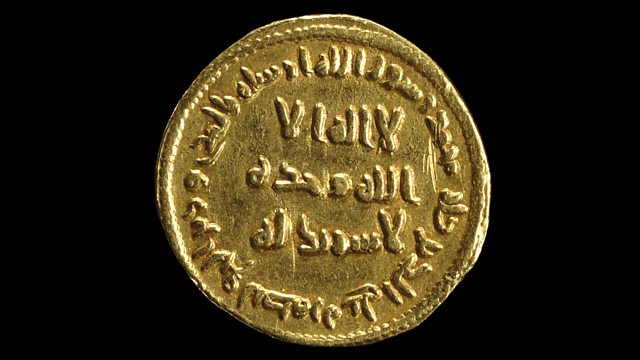Gold Coins of Abd al-Malik
Neil MacGregor's history of the world as told through objects at the British Museum in London. Today, gold coins from Syria sum up one of history's greatest political upheavals.
The history of the world as told through one hundred of the objects that time has left behind. The objects are from the British Museum and tell the story of humanity over the past 2 million years. They are chosen by the museum's director, Neil MacGregor.
This week he is exploring the world along and beyond the Silk Road in the 7th century AD at a time when the teachings of the prophet Muhammad were transforming the Middle East forever. Today he looks at how the Syrian capital Damascus was rapidly becoming the centre of a new Islamic empire. He tells the story through two gold coins that perfectly capture the moment - with contributions from the historian Hugh Kennedy and the anthropologist Madawi Al-Rasheed.
Producer: Rebecca Stratford
Last on
More episodes
Previous
You are at the first episode
![]()
Discover more programmes from A History of the World in 100 Objects about religion
About this object
Location:�����������
Culture: Islam
Period: AD 696-7
Material: Gold
��
This coin represents a defining point in Islamic history: when images of leaders on coins were replaced by text from the Qu'ran. The first coins issued by Caliph Abd al-Malik showed the figure of a ruler. This followed earlier traditions when pictorial images appeared on coins. He later removed the ruler's image and used only texts from the Qu'ran. Replacing images of rulers with Qu'ranic verses emphasised that the Islamic Empire was ruled by God and not by mortal men.
Who was Caliph Abd al-Malik?
The ninth caliph, Abd al-Malik issued this coin. As caliph he was both the religious and political leader of the early Islamic Empire. He consolidated a string of conquests, which included half of the early Christian world and the former Persian Empire. This new Islamic Empire became a model for Islamic states for over 1000 years. One of his many reforms was the creation of a successful Islamic coinage. He is arguably the most important early Muslim leader after the Prophet Muhammad.
Did you know?
- Caliph 'Abl al-Malik was rumoured to have terrible halitosis, earning him the nickname 'Fly Killer'.
A script of elegance and symmetry
By Venetia Porter, curator, British Museum
��
The gold dinar struck in the year 77 of the Islamic calendar, (AD 696-7) is significant for a number of reasons: it is the first issue of Islamic coinage without pictorial representation and represents a decisive break away from a coinage that hitherto had imitated the coins of the Sasanians and the Byzantines, whose territories had been incorporated into the new Muslim empire.
This dinar was struck by Abd al-Malik, fifth of the Umayyad caliphs (reigned AD 685-705) - the Umayyads being the first great dynasty of Islam (AD 661-750) whose capital was at Damascus in Syria. Abd al-Malik not only initiated the reform of the coinage but was also responsible for the construction of one of the most iconic buildings in the Islamic world, the Dome of the Rock in Jerusalem, part of an ambitious plan to build up and consolidate the Muslim presence in Greater Syria. Quite apart from the significance of this coin for the monetary history of the Islamic world, the style of the coin also tells another important story.
The inscriptions proclaim the very essence of the faith of Islam and include the phrase: ‘there is no god but God, he has no associate, Muhammad is the prophet of God’, in addition to other verses from the Qur’an (Qur’an 9:33 and 112). Qur’anic texts also appear in the Dome of the Rock made of mosaic placed high up on the walls of the ambulatory and they are written in the style of script known as Kufic.
Arabic was an oral language only until the Revelation to the Prophet Muhammad in early seventh century Arabia. It developed as a script in order to set down the words of the Revelation to prevent them being lost. The alphabet adopted was one that was based on a style of Aramaic script used by the Nabateans whose capital was at Petra in Jordan. Early developments evolved into Kufic an exceptionally elegant script characterised by letters that are simple and angular in shape. What is crucial about Abd al-Malik’s dinar is that along with the inscriptions in the Dome of the Rock, they both provide us with the concrete markers we need to understand the evolution of this remarkable script: the dinar is dated 77/696-7 and the Dome of the Rock was completed in 72/692. This tells us that by the late seventh century a script had evolved that was intended to reflect and honour the beauty and power of the Revelation. It was as effective written on a tiny coin as large scale on the walls of the Dome of the Rock.
Script became a defining feature of Islamic art developing, over the centuries, complex rules to create elegance and symmetry. Such is the flexibility of the Arabic script that even today, some 1400 years after the appearance of the Kufic script on Abd al-Malik’s dinar, it continues to provide inspiration for modern calligraphers.
Transcript
Broadcasts
- Mon 7 Jun 2010 09:45������̳ Radio 4 FM
- Mon 7 Jun 2010 19:45������̳ Radio 4
- Tue 8 Jun 2010 00:30������̳ Radio 4
- Mon 15 Mar 2021 13:45������̳ Radio 4
Featured in...
![]()
Religion—A History of the World in 100 Objects
A History of the World in 100 Objects - objects related to religion.
![]()
Leaders and Government—A History of the World in 100 Objects
More programmes from A History of the World in 100 Objects related to leaders & government
Podcast
-
![]()
A History of the World in 100 Objects
Director of the British Museum, Neil MacGregor, retells humanity's history through objects





